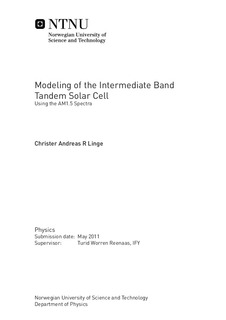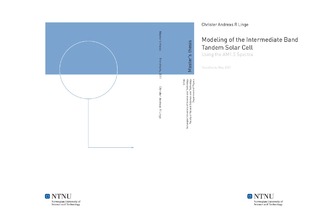| dc.description.abstract | In this thesis the results from simulations of a tandem intermediate band solar cell are presented and discussed. Renewable energy sources have become increasingly important, because of global environmental concerns. To make the solar cell technology more viable as an energy source, the study of how to increase the solar cell efficiency is important. The intermediate band solar cell (IBSC) has been introduced as a cell with potential to enhance the efficiency of the conventional single-junction cell. IBSCs have limiting efficiencies of 63.3%. This limit can be further increased by combining two different IBSCs in a tandem cell or combining an IBSC with a conventional single-junction cell. The principle of detailed balance is used to find the limiting efficiencies for possible band gap combinations. Similar analysis of the intermediate band tandem cell has been done previously for black-body radiation. In this thesis the reference AM1.5 spectra have been used, and concentration levels of 1, 100 and 1000 suns. During the work, a model of the intermediate band solar cell, single-junction cell and the complete tandem cell have been coded in Matlab.The tandem intermediate band solar cell will have six different band gaps and is hence comparable with a six single-junction tandem cell. Tandem cells with combinations of a single-junction cell and an intermediate band solar cell, having in total four different band gaps, have also been simulated.In addition to a higher maximum efficiency, the tandem IBSCs are found to have large ranges of useful band gap energies. Semiconductor materials not considered for the single-junction cell or the single intermediate band cells are viable for making tandem IBSCs.The main results in this thesis conclude that the four terminal tandem IBSC has a maximum efficiency of 54.93% for 1 sun, 62.74% for 100 suns, and 67.23% for 1000 suns. These maximum efficiencies are about 11% higher than that of a single IBSC under the same conditions. The maximum efficiencies for the other tandem cells are all higher than that of a single IBSC, with an increase from 1.50% to 9.05%. A wide range of main band gap combinations for the four terminal tandem cells give high efficiencies, but the range is strongly reduced for the two terminal tandem cell. For variations in the band gaps away from their optimal values, the efficiency is affected mostly by variation of the sub-band gap of the top IBSC. | nb_NO |

